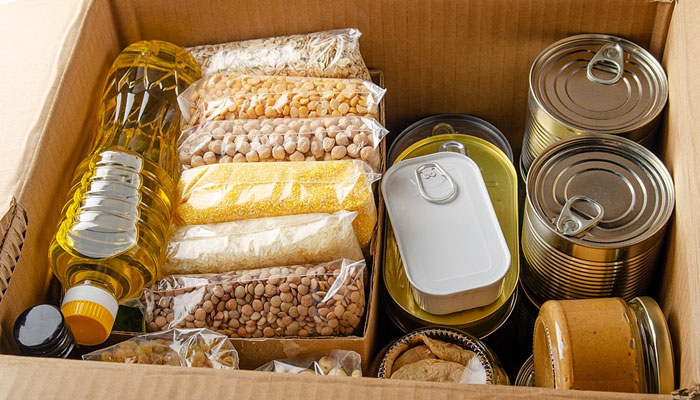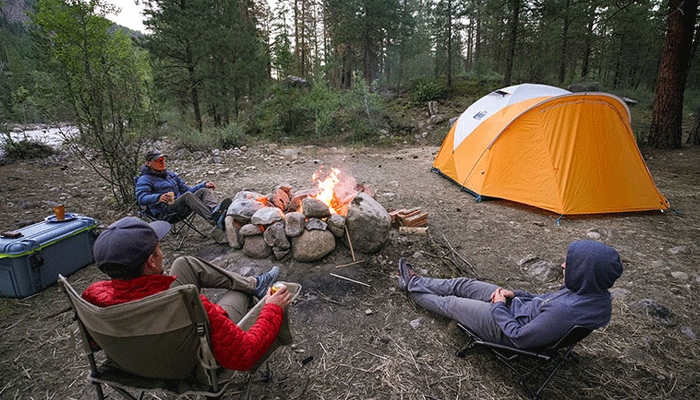
When stockpiling food for emergencies, it’s important to include foods that are non-perishable and offer a balance of nutrients. Consider the dietary needs of members of your household and what foods are most enjoyable to them, and also add items that will help you prepare meals.
For example, dried beans have a long shelf life and can be cooked into soups and stews. They also make a good addition to other emergency foods such as rice and packaged convenience mixes.
Canned Foods
Canned foods are a must-have for any emergency food supply. They have long shelf lives and can be stored in a garage or basement. Additionally, they are easy to transport in case you need to evacuate your home during an emergency or disaster.
You should stockpile canned fruits, vegetables, beans, and meats to have a well-rounded meal supply. These foods will provide your body with the essential nutrients you need to survive in an emergency.
Fruits in cans, especially freeze-dried fruit, last up to 12-18 months when stored unopened in a cool, dry pantry. They are also a great source of vitamin C, which can help combat fatigue during a disaster.
Vegetables in cans are a valuable addition to any emergency food storage, as they are rich in nutrients and can be eaten in a variety of ways. In addition, they are inexpensive, making them a budget-friendly option for stockpiling. Consider exploring Food & Drinks Coupon Codes for potential discounts when adding canned vegetables to your emergency supplies.
Beans are a great source of protein and can be used in many different dishes, including soups and stews. They also have a long shelf life and are easily stored in a cool, dry place.
Evaporated milk, which is a staple in most people’s pantries, has a long shelf life and can be stored without refrigeration. It’s an excellent replacement for fresh milk when it is unavailable, and provides all the benefits of real milk, such as calcium, phosphorous, and iron.
Powdered drink mixes are a useful addition to any emergency food storage because they can be made with just water, and most come in a range of flavors. They are lightweight and can be stored and transported in plastic bags, which makes them an ideal addition to your survival bag.
Canned Fruit
Canned fruits are an important addition to your emergency food stockpile. Not only do they have a long shelf life and not require refrigeration, but they are also a great source of vitamins and minerals.
You should look for canned fruits that are low in sugar and have few preservatives. Some good choices include peaches, strawberries, pineapple, and mangoes.
Another staple to have on hand is canned tuna. Not only does it have a long shelf life, but it is also a great source of protein, which is essential for maintaining energy and health in an emergency situation. If you are not a fan of tuna, Mind4Survival suggests sardines and mackerel as alternative options.
As you begin to build your emergency food stockpile, keep in mind that it is best to purchase these foods in bulk. Purchasing in larger quantities will save you money and also make it easier to store these foods in your home. You will also want to invest in airtight food storage containers to store your bulk purchases. These containers are easy to find at most grocery stores and can be stored in your pantry, basement, or garage. Don’t forget to consider Valley Food Storage Discount Code options for potential savings when buying in bulk.
While you are storing these canned foods, make sure to have a can opener on hand so that you will be able to open the foods when needed. When storing canned foods, you will also want to place them in a cool, dark area and avoid exposing them to direct sunlight or heat. You should also add a first-aid kit to your emergency supplies, including a pair of rubber boots and a raincoat. If you have pets, be sure to include pet food and water in your emergency supply as well.
Canned Vegetables
A well-stocked emergency food supply includes canned vegetables like green beans, corn, and tomatoes. While they may not taste as fresh and wholesome as their freshly picked counterparts, these veggies are still packed with important nutrients and have a long shelf life. Canned fruits and vegetables are also easy to add to soups, stews, and casseroles, or just eat on their own as snacks.
Adding canned foods to your emergency food stash is an inexpensive way to ensure that your family will have the essentials if disaster strikes. However, it’s important to remember that a two-week emergency food supply should include non-canned items as well. The best way to do this is by building meals with the non-canned items you have on hand and then adding in some canned options.
Keep in mind that the processing of canned food can break down some of its nutrients, so if possible try to find organic and low-sodium canned foods. In addition, if you’re planning on storing these foods in an emergency situation, you should store them somewhere that is safe from damage or flooding.
In addition to canned fruits and vegetables, stocking up on canned meats is a good idea for those who have children or pets to feed in an emergency. You’ll need a variety of protein sources, including fish, chicken, beef, and pork.
Lastly, it’s also wise to stockpile some canned milk, which provides both calcium and vitamin D. It also helps prevent bone fractures and wards off osteoporosis. When selecting canned milk, look for organic, reduced-sodium, fat-free, and lactose-free varieties to make sure you have options for different dietary needs. You should also store these products in food-safe buckets to protect them from bugs, dust, and water damage.
Dried Beans
As people began stockpiling food during the coronavirus pandemic, many turned to dried beans. These protein-rich foods are inexpensive and have a long shelf life, making them a must for any emergency food supply. They also provide a high amount of nutrients per serving, such as iron and fiber.
In addition, they can be easily prepared on the stovetop, without requiring power or refrigeration. They’re also relatively lightweight, meaning they’re easy to transport and consume in a crisis.
Beans, peas, and lentils (also called legumes) are one of the world’s oldest cultivated crops. They are high in protein, dietary fiber, and complex carbs. The benefits of eating these foods include increased heart health, lower blood sugar levels, and decreased cholesterol.
To ensure they last, make sure you store them in a cool and dry location. A food storage bag, like the Rubbermaid Brilliance Airtight Food Storage Container, is ideal for this purpose. These containers have an oxygen-absorbing technology that keeps foods fresh longer, as well as a clear lid so you can see what’s inside.
Use your dried beans within a year to get the best taste and nutrition. After that, you can still cook them but they will take longer to soften. You can speed up the cooking process by boiling the beans for 1 minute and then letting them soak in water as they cool.
Milk is another nonperishable item that’s important for any emergency food supply. Evaporated milk, which is also known as powdered milk, has a long shelf life and can be stored at room temperature. It’s also a good source of calcium, which can help prevent osteoporosis and keep your bones strong.
Evaporated Milk
Evaporated milk is shelf-stable cow’s milk that has had about 60 percent of its water content evaporated. It’s then heat sterilized, homogenized, and canned. It can be subbed in for fresh milk or half-and-half in recipes, either savory or sweet. It’s a staple in Asian cooking and is also used to make Latin American favorites like dulce de leche.
It has a much longer storage life than fresh milk and is very nutritious. It can be eaten straight out of the can, added to hot drinks and soups, or diluted and used as an emergency baby formula (once your baby is old enough to have solid food). It’s a great option in areas where fresh milk is scarce or unavailable and it’s an excellent backup if you can’t make it to the store.
A disaster can strike at any time and disrupt normal life for days or even weeks. As you create a survival pantry, it’s important to consider the needs of your family, including any special diets they might require or dietary restrictions. Stocking foods that don’t require refrigeration or cooking, are easy to prepare, and high in calories is essential. A well-stocked emergency food pantry will give you peace of mind in the event of an unexpected disaster. For more information, check out the Saving Gain article on Important Things That Are Included in Long-Term Food Kits. What do you think are the most important items to include in a home emergency food stash? Let us know in the comments below!
Conclusion
Every household has to have a supply of emergency food. Including non-perishable items with a long shelf life, canned goods, and items that meet your dietary restrictions is important. Don’t forget to rotate your stockpile and keep it in a cool, dry place. Being prepared for an emergency can make all the difference in keeping yourself and your loved ones safe and fed.








